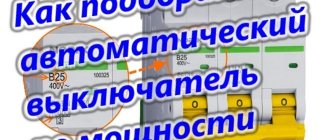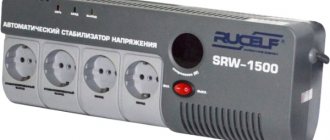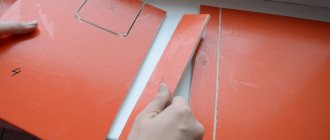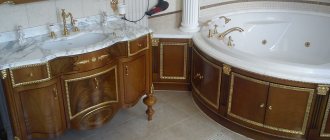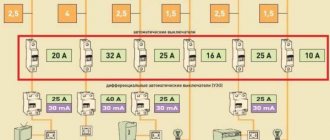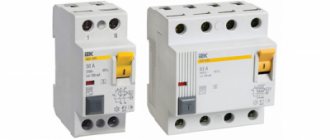When carrying out electrical installation of an incoming electrical panel, home craftsmen without the necessary experience often do not know in what sequence the elements of protective automation are connected. Such gaps in knowledge can lead to dire consequences during operation. This is especially true for the inclusion of residual current devices in the circuit. If everything is simpler with RCBOs, then the question of where to install the RCD (before or after the machine) requires a detailed review. Today’s article will discuss how to carry out such an installation, as well as the sequence of arrangement of protection elements for the home electrical network.
The principle of operation of an RCD and its difference from a differential machine
The need to install a residual current device has not been disputed by professional electricians for a long time, but errors in its connection are common even to some of them. This device serves to protect a person from electric shock in the event of a leak as a result of insulation breakdown or excessive dampness and requires high-quality grounding. When connecting an RCD, 2 wires (at 220 V) or 4 (at 380 V) are used. The resulting current leakage creates a potential difference across the coils of the device, which leads to cutoff.
However, such a device has one significant drawback - it is not able to detect an overload in the network or a short circuit, which can lead to its failure without removing the voltage. That is why the RCD requires additional protection, in contrast to the residual current circuit breaker (RCBO).
Which comes first RCD or automatic
Today you will learn about the protection devices that must be in the switchboard, the order of their connection and the necessary characteristics.
This story is for ordinary ordinary residents, so that they have at least some idea of what devices must be placed in the distribution board of a house or apartment, to protect electrical wiring, connected household equipment, as well as to protect people living in it from electric shock. indoors.
You may ask: Why does an ordinary citizen need such knowledge? I answer: - To understand and understand whether a switchboard assembled independently or by an invited electrician provides sufficient protection, and not to look at it with rounded eyes and unquestioningly believe every word he says.
Usually, “super” busy and very demanding electricians do not like to be controlled. But in the end, the customer receives a miracle shield for a tidy sum, which is unsuitable for use for its intended purpose, namely, ensuring the electrical safety of their home. I want to give you some tips that everyone should know.
First.
To protect against short circuits and overload of electrical wiring, in the distribution board with single-phase wiring, an input two-pole circuit breaker must be installed at the beginning to disconnect both zero and phase at the same time. You cannot install a single circuit breaker at the input only for a phase. Under certain conditions, a phase may pass through the neutral wire, which will lead to undesirable consequences, and you will not be able to turn it off if there is a single-pole circuit breaker.
This question is often asked. Is it necessary to install another input circuit breaker indoors if there is already one on the floor or outside the premises on the street? My opinion - it's a must! You won’t look for the keys, open the doors and run outside to turn off the power supply if a dangerous situation suddenly arises. It is much easier and faster to do this indoors.
The essence of the work of protective elements in a complex
In order to understand where to install the RCD (before or after the machine), a novice home craftsman needs to study how his work will be carried out. For example, it is worth taking the simplest assembly, which contains a metering device, a residual current device, and circuit breakers with output to only one power line. In this case, the voltage coming from the transformer substation, passing through the meter and the RCD, must reach the outlet. However, if there is no protection and a short circuit occurs, the residual current device burns out.
But a release is also needed in front of the meter, which means that installing an RCD after the input circuit breaker will be the right solution. It turns out that protection is necessary on both sides. However, such a two-pole machine is installed before the electricity meter. There is no need to install it directly in front of the residual current device, but they are necessary in the section from the RCD to the consumer. However, such AVs will differ from the introductory ones in various parameters, which should be paid attention to separately.
Connection diagrams for RCD with circuit breaker
Friends, to understand this issue, let's look at several diagrams for connecting an RCD and a circuit breaker. And in each connection option we simulate an emergency situation with the flow of short circuit current.
Connection option No. 1. One RCD for several groups of machines
With this connection scheme, one RCD protects several group lines. In this case, the residual current device is installed on top, and after it, circuit breakers are installed for different groups of consumers.
This scheme is very popular today and allows you to significantly save your budget.
| For those who think that it is impossible to connect like this, the rules of the PUE P.7.1.79 are quite acceptable. |
By the way, on the website Electrician in the House, I already told you how to make such connections. Read the article connecting an RCD to a group of machines. Now imagine the situation that a short circuit has occurred in one of the group lines. For example, in group No. 2. The figure shows the movement of the short-circuit current.
Here are some examples of the use of such circuits in electrical panels:
In this case, the short circuit current will flow along the following path: RCD - automatic circuit breaker of group No. 2 - supply cable - consumer.
Many will find this connection diagram incorrect, since the machine is located after the RCD and is not capable of eliminating the effect of short circuit current. A huge current will flow through the RCD, and it will definitely burn out. What do you think, will the RCD burn out or not? Take a break and write your opinion in the comments without reading the article to the end. Let's look further at the question of where it is necessary to install the ouzo before or after the machine.
Connection option No. 2. Installing an RCD upstream of the machine
This circuit is assembled in this way: residual current device – circuit breaker – power cable – consumer. That is, in this case, the RCD is installed before the machine . And such schemes are far from uncommon. Here are some assembly examples.
An example of the passage of short circuit current during a fault.
If a fault occurs, the circuit breaker will trip, but before this moment the short circuit current will have already passed through the RCD. For many users, this assembly method will also seem incorrect.
Connection option No. 3. Installation of RCD after the machine
With this connection scheme, the machine is installed first, and then the RCD. A clear example of such an assembly.
In the event of a short circuit, the current will flow along the following path: circuit breaker - RCD - power cable - consumer. This is indicated in the figure.
Again, for many, such a scheme will seem the most correct since along the path of the short-circuit current, the first thing that passes through the circuit breaker is that it will turn off in turn and the RCD will not be harmed in this case.
Which machines should be installed after the RCD?
Quite often, novice home craftsmen have a question about how the introductory AV differs from those installed after the residual current device. The following criteria can be highlighted here:
- maximum current load (it is higher on the input circuit breaker);
- number of poles (2 or 1);
- main purpose.
The input circuit breaker (with proper switching of the remaining protection) is very rarely used for its intended purpose. More often than not, the rest of the electrical panel's equipment trips first. It is mainly used for general shutdown of the home network during repair work. Its rated current load is higher than that of other elements. As inputs, two-pole AVs are used, through which both the phase and neutral wires pass.
The rating of the machines after the RCD is lower. This parameter is calculated depending on the planned load on a particular line. However, it is worth understanding that it should not exceed the same indicator of the residual current device. The main task of a linear single-pole circuit breaker is to cut off the group when an overload or short circuit occurs on it before the RCD fails.
Installation of ouzo before or after the machine
In fact, I believe that this question can be classified as a question of “which came first, the egg or the chicken”?
Let's figure out what the danger is? The danger is that the residual current device does not have overcurrent protection. If an overload or short circuit occurs in the circuit, the ouzo will not work, which is why it is connected in tandem with the machine.
The short circuit current can be hundreds of times higher than the rated current. It is easy to understand that nothing good should be expected when such large currents pass through the RCD. In this mode of operation, its internal parts may be damaged and contacts may burn out, and the device may simply lose its functionality.
And the sad thing about all this is the cost of the RCD, which is an order of magnitude higher than the cost of the circuit breaker.
IN THE OPINION of some readers, depending on where the residual current device is installed, it will depend on whether it is damaged or not. What can I say, I myself used to think that sequence matters.
Approximate switching diagram using one residual current device
The location of the automation in the input electrical panel may differ. Usually one residual current device for all outgoing groups is sufficient. But even if several similar elements are used, the question “install an RCD before or after the machine” is incorrect - installation is required on both sides. It is worth considering in what sequence the elements will be arranged.
- Input two-pole automatic or feeder switch.
- Electricity metering device.
- Residual current device.
- One or more machines, depending on the number of lines.
Quite often, home craftsmen play it safe and install an additional AV between the electricity meter and the RCD, but if all the calculations are made correctly, this element is completely useless.
Connection in an apartment and in a private house
For a washing machine,
the connection diagram in the apartment is carried out only via a single-phase network. For this reason, the connection is made in the following order:
Connection in the apartment
If you have power consumers of electricity in your apartment, for example, a washing machine or an electric oven, then it is recommended to additionally connect an RCD protective device.
As for connecting the machine in a private house, the connection sequence is as follows:
- Introductory machine.
- Electricity meter.
- Automatic from 100 to 300 mA, the choice is made depending on the amount of current consumed by all household appliances.
- Automatic machine for individual current consumption. Typically, 10 to 30 mA is used.
So, we have examined with you some of the features and differences of connecting an RCD in certain circumstances. Most importantly, remember that if you have no idea at all about this system, then it is better not to experiment.
A few words about typical errors when connecting an RCD:
To correctly install the RCD, we suggest that you familiarize yourself with some of its connection diagrams:
Residual current device
Connecting an RCD with automation
Connection to 380V network
Four-pole RCD without zero
Apartment group panel
1. Connecting a four-pole RCD to a three-phase network using a neutral. Your diagram shows a single-phase network. Above the green wire the inscription is blue. This wire should be yellow-green. 2. Connecting a four-pole RCD in a single-phase network. The figure shows a two-pole (single-phase) RCD.
Alexander! Thank you very much for your relevant comments. These shortcomings will be eliminated in the near future. We apologize for any inaccuracies in the illustrations posted.
- How to connect a washing machine with your own hands
- Instructions for replacing heating elements in a washing machine
- How to make an electric heated floor
- Operating principle of the air conditioner
Video about installing electrical wiring yourself
Assembly for several residual current devices
This option is applicable if separate protection is required for household appliances installed in wet areas (washing machine, boiler). In this case, the RCD mounted on a separate line should have lower performance than the main one. Often additional residual current devices are installed directly next to the protected equipment, outside the distribution cabinet. But here, too, the experience of switching the input panel should be taken into account. The answer to the question of where to install the RCD (before or after the machine) will be the same.
The most rational option for such protection of individual equipment would be to purchase a compact RCBO. Such devices are plugged into a regular outlet and can withstand current up to 16A, which is quite enough to operate a dishwasher or washing machine. In addition, they do not require any skills or knowledge in the field of electrical installation.
Important! Connecting an RCD after the machine without its additional protection is possible, but it should be understood that in this case the AV rating must be one step higher than the same rating of the residual current device. In this case, even if a short circuit occurs, nothing extraordinary will happen. The time-current characteristic of the machine (about 0.02 sec.) will make it possible to cut off before the RCD fails. However, this scheme is applicable only for one group.
RCD selection
In most cases, the following solution is suitable: after the input circuit breaker we install a 100 mA RCD, and on the outgoing lines - 30 mA. We install a 10 mA RCD on a separate line in a damp room, for example in a bathroom. The rated current of the RCD must be no less than the current of the machine installed in front of the RCD.
Is the RCD electromechanical or electronic?
Electromechanical RCDs are quite suitable for domestic use; in addition, they are cheaper than electronic ones and do not require external power for their operation. In the following video, the author demonstrates a method for determining the type of RCD.
When to use an adapter with an RCD?
In old apartments, village houses, and dachas there is not always grounding, and as a result, an RCD is not provided. Therefore, to ensure safety when using electrical equipment, you can use an adapter with an RCD.
Typically used for kitchen tiles, water heaters, washing machines - electrical equipment with a metal body and complex circuitry.
In most cases, a 16 A adapter with a trip current of 30 mA will do.
Grounding and its role in the operation of the residual current device
When installing such equipment, you need a circuit that does its job correctly. Regardless of whether the RCD is installed before or after the machine, without properly installed grounding it will not be able to provide adequate protection. Of course, it will protect you from death, but you will have to experience a sensitive, unpleasant discharge. It's worth figuring out why this happens.
From a school physics course, everyone knows that current flows along the path of least resistance. If the insulation breaks down and a phase wire comes into contact with the body of a household appliance, its metal parts become energized. If the grounding is functioning properly, current will "flow" along the path of least resistance, creating a potential difference in the coils of the residual current device, resulting in tripping.
What happens if there is no normal circuit? In this case, the device will be constantly energized. If a person touches it, then a non-lethal, but very sensitive discharge is provided. In this case, the current will also rush to the ground, but through the body. Of course, the RCD will turn off quite quickly, but such a shock is also unpleasant.
Connection diagrams for RCD with switch
Protective equipment must be connected using two cables. The first will carry the load current, the second will be directed to the external circuit from the consumers. In order not to think about installing an RCD before or after the machine, you should use popular schemes.
For several groups of difavtomats - one RCD
Clause 7.1.79 of the PUE allows for the protection of several lines using an RCD. The device needs to be placed on top, then the switches on the consumer groups. In case of short circuits, the current passes through the RCD to the group circuit breaker, then to the power cable and to the consumer. If the rating of the devices is selected correctly, none of them will be damaged.
The advantages of implementing the scheme include saving money and space in the distribution panel. The downside of the connection is that all groups are disconnected after the RCD is triggered.
Installation of RCD to the machine
The diagram provides for installation in the following sequence:
- Safety shutdown device.
- Difavtomat.
- Power cord.
- Consumer.
Connecting residual current devices: basic rules
When switching an RCD (before or after the machine, it doesn’t matter), many people make mistakes that lead to its incorrect operation. The most common of them is the connection between ground and zero. Such an action will lead to causeless operation when turning on household appliances. The same can be said about the jumpers inside the sockets connecting the neutral and ground contacts. This often happens when the owner moves to a new apartment and installs an RCD that was not there before. If the device turns off for no reason, the action algorithm should be as follows:
- When the RCD is turned on, the “TEST” button is pressed. There must be a cutoff.
- The absence of contact between zero and ground in the distribution cabinet is checked.
- The sockets are opened one by one. The connection inside must be made correctly, without jumpers.
- If the reason is not found, it is necessary to check the switching in the junction boxes.
However, it often happens that there is a breakdown and a short circuit to the housing. Therefore, before performing the above actions, you need to turn off all household appliances from the network, and then turn them on one by one. If an RCD is triggered on one of them, it is necessary to try another device equipped with a plug with a grounding contact at the same point.
Checking the residual current device
This is one of the most important activities in the periodic maintenance of electrical cabinet equipment. Provided that all the wiring in the apartment or private house is done correctly and regardless of whether the RCD is installed before or after the machine, it can be checked in several ways. A common option used by the majority of electricians is a multimeter, but you shouldn’t stop there. It is much more interesting to consider two other methods:
- An incandescent lamp is an option for checking the functionality of the RCD on site.
- AA battery - tested upon purchase, without connecting to the network.
It is worth considering both methods in more detail.
Using an incandescent lamp
If the home technician is sure that the grounding is functioning correctly, the action algorithm is as follows. First you need to determine the phase contact in the socket. After this, one of the wires coming from the lamp socket is connected to it. The second wire should touch the ground contact. If the residual current device is operational, it will operate, cutting off the voltage.
Very important! If a zero is connected to the ground pin, a short circuit will occur. That is why such actions should be performed if the home master is 100% sure that the wiring is done correctly. Otherwise, it is better to use the second method.
Three-phase connection diagram
I give an example of connecting a 3-phase RCD to an ASU (input switchgear) of a private residential building.
A 3-phase connection is provided because It is assumed that the house has a 3-phase load (machines, electric heating, pumps). Permitted power for residential buildings. persons 15 kW, power is limited by an input circuit breaker at 25 A. For simplicity and clarity, I give one 3-phase and 1-phase connection. It is assumed that a bathhouse or barn is connected (the connection diagram is identical to the house connection diagram). As an introductory device, I use a 100 mA RCD (fire protection) with a time delay. A time delay is needed to selectively turn off buildings, because Each building has its own fire protection RCD for 100 mA without delay, followed by protective ones (10 mA and 30 mA). Video about the correct connection of an RCD using the example of an apartment panel:
Testing functionality with a AA battery
This method can be applied when purchasing. If the RCD is already installed, it is necessary to turn off the input circuit breaker and dismantle it. To work, you will need two pieces of wire and a galvanic cell. The cores are connected to a pair of phase or neutral contacts (input/output). A battery is connected to the other ends of the wires, which creates a field on one of the coils. The potential difference that appears causes the protective shutdown device to cut off. If this does not happen, then the RCD is inoperative.


